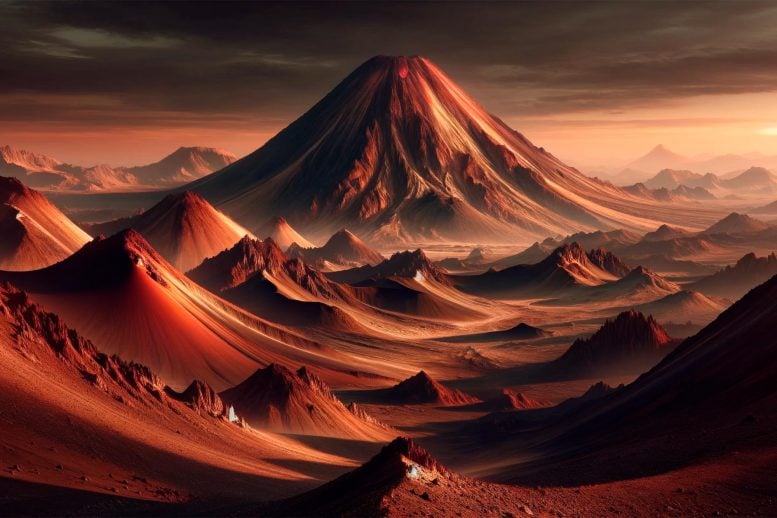
A study uncovered mummified mice on high-elevation Andean volcanoes, revealing that mammals can survive in extreme, Mars-like conditions. This finding challenges our understanding of vertebrate life’s physiological limits and prompts further research into these mice’s survival mechanisms.
The barren, wind-blasted peaks of volcanoes in the Puna de Atacama, straddling Chile and Argentina, bear a striking resemblance to the Martian surface, characterized by a sparse atmosphere and frigid conditions. Situated at staggering heights exceeding 6,000 meters, these summits were previously thought to be inhospitable for mammalian existence. However, a study recently published in the journal Current Biology presents a groundbreaking discovery: mummified mice found in these harsh landscapes, pushing the known boundaries of vertebrate survival on our planet.
“The most surprising thing about our discovery is that mammals could be living on the summits of volcanoes in such an inhospitable, Mars-like environment,” says senior author Jay Storz, a biologist at the University of Nebraska, Lincoln. “Well-trained mountain climbers can tolerate such extreme elevations during a one-day summit attempt, but the fact that mice are actually living at such elevations demonstrates that we have underestimated the physiological tolerances of small mammals.”
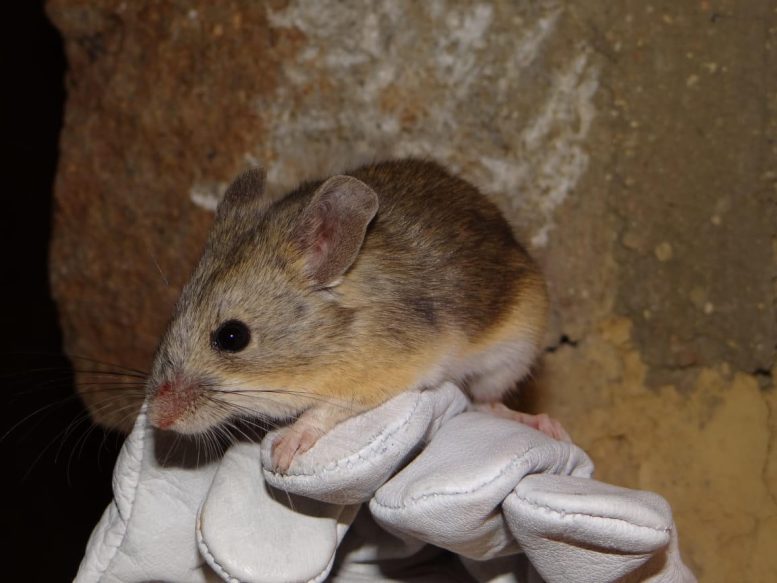
This photograph shows a member of a species of leaf-eared mouse called Phyllotis vaccarum. Credit: Marcial Quiroga-Carmona
Storz and his colleagues discovered the first mouse mummy on the summit of Volcán Salín by chance when they stumbled across the desiccated cadaver at the edge of a rock pile. But, now knowing what to look for, they soon turned up others.
“Once my climbing partner and I started searching through the rest of the rocks, we found seven more mummies on the same summit,” Storz recalls.
They then started searching systematically on the summits of all the Andean volcanoes. So far, they’ve searched 21 volcano summits, including 18 with elevations over 6,000 meters. All told, they’ve found 13 mummified mice on the summits of multiple volcanoes with an elevation greater than 6,000 meters. In some cases, the mummies were accompanied by skeletal remains of numerous other mice.
Video showing the site where 4 mummies were excavated from a site on the summit of Volcán Púlar (6,233 m), Chile. Credit: Jay Storz
Radiocarbon Dating and Genetic Analysis
Radiocarbon dating showed that the mummified mice found on the summits of two volcanoes were a few decades old at most. Those from a third site were older, estimated at 350 years old at most. Genetic analysis of the summit mummies demonstrated that they represent a species of leaf-eared mouse called Phyllotis vaccarum, which is known to occur at lower elevations in the region.
“The discovery of the mouse mummies on the summits of these freezing, wind-scoured volcano summits was a huge surprise,” Storz says. “In combination with our live-capture records of mice on the summits and flanks of other high-elevation Andean volcanoes, we are amassing more and more evidence that there are long-term resident populations of mice living at extreme elevations.”
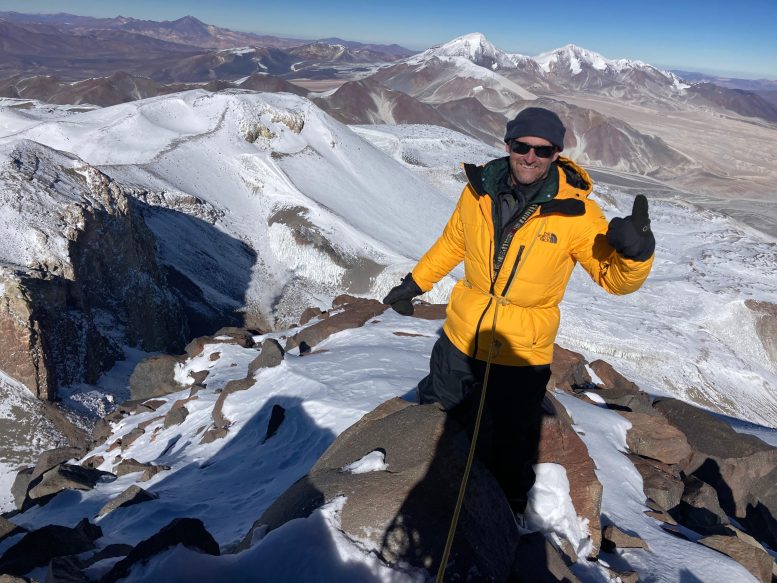
This photograph shows a member of the research team at the summit of Ojos del Salado, 6,893 m (Puna de Atacama, Chile-Argentina). Credit: Mario Pérez Mamani
Exploring the Mysteries of High-Altitude Mammalian Life
The finding now raises important questions, including how mammals can live in a barren world of rock, ice, and snow where the temperatures are never above freezing, and there is roughly half the oxygen available at sea level. It’s not clear why the mice would have climbed to such heights. Over 500 years ago, Incas were known to conduct human and animal sacrifices on the summits of some Andean peaks. However, the researchers note that the mummified mice from the volcano summits couldn’t have been transported there by the Incas, given that none are old enough to have co-existed with them.
In ongoing work, the researchers are investigating whether the high-elevation mice have special physiological traits that enable them to survive and function in low-oxygen conditions. They’re conducting physiological experiments on captive mice that were collected from high elevations to find out. They’re also continuing their mountaineering surveys of small mammals on high Andean peaks in Argentina, Bolivia, and Chile.
“With our mountaineering biological surveys in the Andes, we keep making surprising new discoveries about the ecology of extreme high-elevation environments,” Storz says.
Reference: “Genomic insights into the mystery of mouse mummies on the summits of Atacama volcanoes” by Jay F. Storz, Schuyler Liphardt, Marcial Quiroga-Carmona, Naim M. Bautista, Juan C. Opazo, Timothy B. Wheeler, Guillermo D’Elía and Jeffrey M. Good, 23 October 2023, Current Biology.
DOI: 10.1016/j.cub.2023.08.081
This work was funded by grants from the National Institutes of Health, the National Science Foundation, the Geographic Society, and FONDECYT.




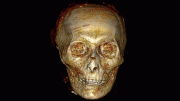



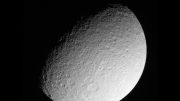
Cached by raptors maybe?
Even the “Mars-like” description is misleading. Mars is so unlike earth, any place on earth, in such impactful ways that this author is deceiving people with the “mars-like” descriptor.
It’s a shame that so many people have such poor reading comprehension. Those volcanic peaks are indeed Mars-like in that there is very little oxygen in the very thin air and the temperatures never rise above freezing.
My question is what do the mice find to eat in those conditions?
Half the oxygen of sea level is still far more than the atmosphere of Mars, which is only 1% as thick as Earth’s and mostly CO2.
There are numerous villages above 16,000′ so I don’t find this very surprising from an oxygen standpoint.
How do they survive there?
The mice live off oxygen, it may seem strange but that’s all they need.
Probably dropped by birds
I have to agree with many on here. This title and article is misleading. Yes there are conditions similar to mars, but it is not mars. Also, there is no way of knowing if those mice got there on their own or if another animal such as a predator bird or other things had carried them there. As for Martian exploration we haven’t found any living things on Mars to prove that mammals ever existed there. It really doesn’t bring any real value to the discussion since it’s a completely different planet. But, I love a good Sci-Fi story too. Why don’t we stay in reality when we’re promoting science and not just speculate. Stick with what’s being proven by Martian exploration, not by our thoughts of what’s here on Earth.
Thank you. You make more sense. What did they eat? I wonder.
Drake 13
Thank you. You make more sense. What did they eat? I wonder.
I was curious as to what caused the mummification. Given the extreme temperatures at that height, why weren’t they merely frozen? What conditions caused the dessication, yet preserved the mice?